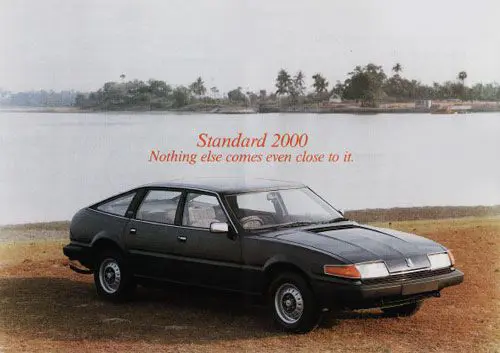The SD1 From India – The Story of The Standard 2000
25 July 2023
Of all the rare Rover SD1 variants – the V8S, the Vanden Plas Series 1, the 2400SD Turbo – the Standard 2000 from India is possibly the most interesting. In theory it looked set to appeal to the discerning motorist – but in reality, the project had sone very fundamental flaws.

In 1981 Standard Motor Products approached British Leyland (BL) with a proposal for an Indian version of the Rover SD1. Since 1951 the Madras concern has built local versions of the Vanguard, Eight/Ten, Atlas van and the Triumph Herald. By the early 1980s the Austin Rover Group division of BL was already planning the 800, so the idea of a new role for SD1 was an appealing one.
Leyland and Standard concluded a deal in March 1984 for 12,000 SD1 body panels to be sent from the UK to Madras. The 2000 made its bow April of 1985 and the charmingly immodest advertisements promised ‘the only Indian car with advanced features that spell class’.
Electric windows, power steering, a stereo cassette player and central locking were indeed noteworthy and the sales copy also stated the Standard 2000 was “The only Indian car whose counterparty, the Rover 2000, is currently being manufactured in the UK”. This was a not terribly subtle reference to its potential rival, the Hindustan Contessa, which was based on the 1972-1978 Vauxhall Victor FE.
The Standard 2000 did not, however, feature the O series engine of its British counterpart. Local content regulations dictated power would be from the venerable 1991cc Vanguard four-cylinder plant fitted with twin SU carburettors and a Heron head. The four-speed transmission was also created in India. The 2000’s top speed was 91 mph while Standard’s modified suspension raised the SD1 body height by an inch to cope with often poor roads.
In 1987 Graham Robson wrote in Autocar that the original factory demonstrator was “still impressively free of rattles and completely dust proof.” But the 2000 was destined to be an exclusive sight.
A vast price of 212,00 rupees (approximately £12,000) meant the Indian SD1 was the province of senior government officials and film stars. By contrast, Hindustan sold the Contessa for 84,000 rupees.
The production of body panels was transferred to India after the Rover 800’s launch in July 1986. However, some owners complained about the engine and transmission quality of “India’s Finest Car”. The end came when concerns that the 2000 failed to meet India’s stringent fuel efficiency requirements led to an official investigation. Consequently, the factory closed, and production ceased in 1988 after just 3,408 units. As a postscript, Rimmer Brothers acquired many of the parts.
Perhaps the 2000 needed to be filed under the category of ‘Ambitious Failures’. A change of engine may have enhanced its chances; replacing the 1.5-litre BMC B-series unit with a 1.8-litre plant improved the rival Contessa. But that 212,000 rupees price tag meant the Standard-built SD1 was never to be a common sight. Meanwhile the 1983 Maruti Suzuki 800 benefited from the liberalisation of the Indian car market.
But to display the 2000’s many charms, here is a totally wonderful Bollywood song & dance number staged at the Standard factory, Take it away Kamal Hassan!
